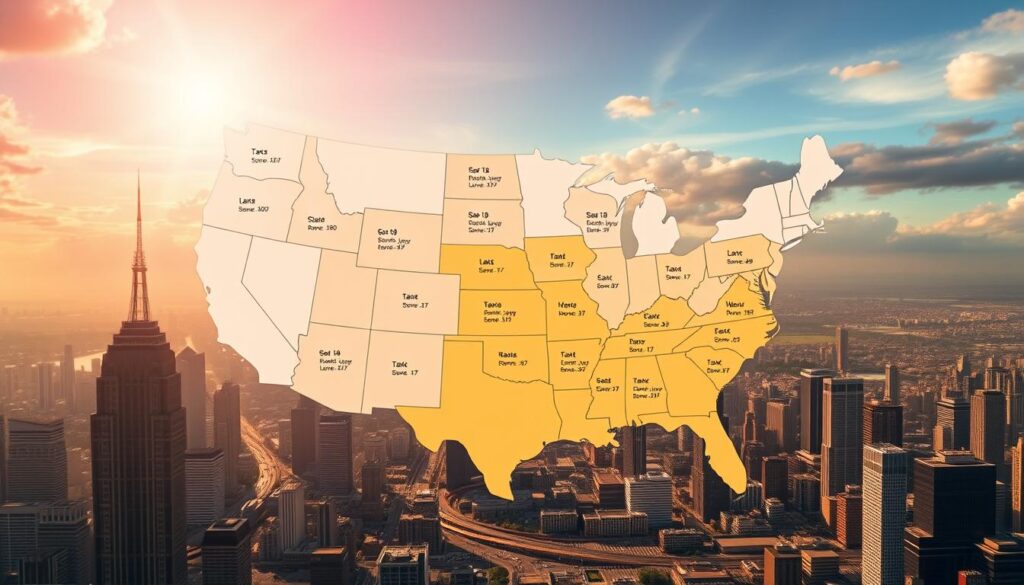The rise of smart technology is reshaping financial workflows. Over 79% of professionals predict these tools will transform their field within five years, according to Thomson Reuters. Automated systems now handle complex calculations, reducing errors and saving time.
Most experts see this shift positively—84% believe it improves accuracy while maintaining compliance. However, questions remain about data security, with 65% urging caution. Clear documentation remains essential, especially for IRS requirements.
This evolution brings new opportunities. Whether you’re managing independent projects or enterprise-level operations, understanding these systems helps streamline reporting. The focus isn’t just on efficiency—it’s about building trust through transparency.
Key Takeaways
- Smart tools are becoming vital for financial accuracy
- Most professionals support this technological shift
- Automation reduces filing mistakes significantly
- Data protection remains a top priority
- Clear records ensure compliance with regulations
Tax Guide for Generative AI: How to Report ChatGPT-5 Income
Not all AI-generated revenue is equal—some triggers tax obligations, while others don’t. The IRS treats payments from automated services as taxable if they meet «trade or business» criteria. This includes client fees, subscriptions, and even API usage charges.
When Does AI Revenue Become Taxable?
Royalties from content creation, like ebooks or articles, often require Form 1099-NEC. For example, earning $200 per article or $5k monthly from copywriting services counts as reportable income.
«The IRS distinguishes hobbies from businesses based on profit motive and regularity.»
Common Monetization Scenarios
Freelancers using ChatGPT-5 for coding or consulting must track payments. Kentucky even applies a 6% sales tax to prewritten software access. International clients add complexity—always separate personal and business tool usage.
- Freelance programming: Client payments are taxable.
- Ebook publishing: Royalties need documentation.
- Chatbot consulting: Fees fall under self-employment tax.
Mixing personal and professional use blurs compliance lines. Keep clear records to avoid audits.
Understanding Tax Forms for AI Income
Digital earnings require specific documentation—here’s how to match them correctly. Whether you’re freelancing or selling content, the IRS demands precise filings. Over 44% of professionals now rely on automation to simplify this process.
Form 1099-NEC or Schedule C?
Use Form 1099-NEC for contract work exceeding $600 annually. Clients must issue this if you provide services like coding or consulting. For ongoing ventures, Schedule C tracks profits/losses and unlocks deductions.
Freelancers often deduct home office costs, software subscriptions, and even GPU depreciation. QuickBooks syncs seamlessly, auto-categorizing expenses for compliance.
Royalties and Special Cases
*Royalties* from ebooks or music need Form 1099-MISC. The IRS treats these as passive income, separate from service fees. Track payments monthly to avoid April surprises.
| Form | When to Use | Deadline |
|---|---|---|
| 1099-NEC | Contract work >$600 | Jan 31 |
| Schedule C | Self-employment revenue | April 15 |
| 1099-MISC | Royalties | Feb 28 |
«Misclassifying contractors triggers audits—always verify worker status.»
Quarterly deadlines (April 15, June 15, etc.) help spread payments. Set calendar reminders or use apps like TurboTax for alerts.
Deductions You Can Claim for AI Tools
Smart tools aren’t just about productivity—they can also trim your tax bill. Over 42% of professionals use automation to reclaim time for high-value work, according to Thomson Reuters. By identifying eligible write-offs, you can boost your bottom line while staying compliant.
Maximizing Home Office Benefits
Freelancers working remotely can claim home office expenses. The IRS offers a simplified method: deduct $5 per square foot (up to 300 sq ft). Alternatively, track actual costs like rent, utilities, and internet—just ensure the space is used exclusively for work.
Software and Subscription Write-Offs
Essential tools like ChatGPT Plus or GitHub Copilot subscriptions are fully deductible. Kentucky even allows SaaS input VAT deductions. Keep receipts and note renewal dates—audits often target unverified expenses.
«Documentation is your shield. Apps like QuickBooks auto-categorize expenses, reducing errors.»
Hardware and R&D Credits
Investing in GPUs or servers? Compare Section 179 (immediate deduction) vs. bonus depreciation (phased write-offs). Developing AI models may qualify for R&D credits—consult a specialist to navigate Form 6765.
| Deduction Type | Best For | Limit |
|---|---|---|
| Section 179 | Immediate hardware costs | $1.16M/year |
| Bonus Depreciation | Long-term investments | 80% in 2023 |
| R&D Credit | Model development | 20% of expenses |
Mileage for client meetings or conferences? Track trips with apps like MileIQ. Every 58.5 cents per mile adds up—just log dates and purposes.
State-Specific Rules for AI Revenue
State tax laws for digital services vary widely—knowing the differences keeps you compliant. While some states tax AI tools as software, others treat generated content as taxable goods. Over 18 states now have unique rules for automated revenue streams.

Kentucky’s Sales Tax on SaaS
Since 2023, Kentucky applies a 6% sales tax to prewritten AI software access. This includes subscriptions like ChatGPT Plus or Midjourney. Freelancers using these tools for client work must:
- Collect sales tax if based in Kentucky
- Document exemptions for out-of-state clients
- File quarterly returns using Form 51A102
California’s Digital Goods Threshold
California taxes AI-generated ebooks, music, or art as digital products. Sellers crossing $500k in annual sales must register and collect tax. The state also enforces nexus rules—earning $50k+ from California clients triggers obligations.
«Multi-state freelancers should track revenue by location. One missed filing can lead to penalties.»
Comparing State Approaches
Texas and Florida exempt most AI services, while New York and Massachusetts require income source tracking. Use this checklist for compliance:
- Texas: No tax on AI consulting or coding
- Florida: Exempts SaaS unless bundled with hardware
- New York: Mandates reporting for earnings over $300k
| State | Tax Type | Threshold |
|---|---|---|
| California | Digital goods | $500k sales |
| Kentucky | SaaS access | 6% rate |
| Texas | Exempt | N/A |
Economic nexus laws add complexity. If your AI business serves clients nationwide, prioritize states where you exceed revenue or transaction thresholds.
How AI Is Changing Tax Preparation
Advanced algorithms are revolutionizing how professionals handle financial documentation. What used to take weeks of manual review now happens in minutes with smart analysis. Over 70% of audit research time disappears when using these systems, according to Thomson Reuters data.
Speed Meets Precision
Tools like CoCounsel analyze 500-page contracts in under a minute—faster than most humans can skim. This efficiency transforms workflows:
- Traditional process: 3-week review → manual entry → error checking
- Enhanced workflow: Instant analysis → auto-populated forms → risk alerts
Machine learning spots audit patterns humans miss. One firm recovered $50k in overlooked R&D credits through automated discovery. These systems cross-reference thousands of cases to identify savings opportunities.
Eliminating Costly Mistakes
Human error drops by 38% when using verification tools. Natural language processing (NLP) even interprets complex IRS notices, highlighting action items. But beware—free versions often lack critical updates post-September 2021.
«Real-time crypto calculations via blockchain integration prevent reconciliation nightmares during filings.»
The best platforms offer live synchronization with banking APIs. This means no more April surprises—your liability updates with each transaction. While the technology isn’t perfect yet, the accuracy gains are undeniable.
Implementation does require initial setup. However, most professionals recoup this time within two filing cycles. The key is choosing systems that grow with your needs rather than locking you into rigid frameworks.
Ethical Concerns When Using AI for Taxes
Balancing efficiency with ethics becomes crucial when automated systems handle sensitive financial data. Over 65% of professionals cite data protection as their top concern, per Thomson Reuters. While AI accelerates workflows, it also introduces new vulnerabilities.
Protecting Sensitive Information
AI tools processing health-related deductions must comply with HIPAA. The FTC Safeguards Rule also mandates encryption for financial data. Follow these standards:
- Use end-to-end encryption for client documents
- Choose SOC 2-certified platforms like TurboTax Secure
- Audit third-party vendors annually for compliance gaps
«Human oversight remains essential—AI can’t replace judgment calls on sensitive cases.» — Department of Labor
Algorithmic Bias and Fairness
Automated systems sometimes inherit human prejudices. A 2022 study found property tax algorithms overvalued homes in minority neighborhoods by 12%. To mitigate bias:
- Test tools with diverse data sets before deployment
- Demand transparency in decision-making processes
- Document all adjustments made to AI-generated advice
Global Data Regulations
International clients? Compare these frameworks:
| Regulation | Scope | Key Requirement |
|---|---|---|
| GDPR (EU) | All personal data | Explicit consent |
| CCPA (California) | Residents only | Opt-out rights |
IRS Circular 230 holds AI-generated advice to the same accuracy standards as human preparers. Always verify outputs before filing.
Audit Risks and How to Mitigate Them
The IRS now uses advanced algorithms to flag potential audit targets. Their Discriminant Index Function (DIF) scores analyze 63 data points in your return, from deduction ratios to income patterns. Over 34% of selections now stem from these automated risk assessments.
- 70%+ deduction ratios: Claiming excessive write-offs relative to income
- Round-number expenses: $5,000 exactly for «software costs» raises suspicion
- Inconsistent state filings: California earnings reported but no corresponding tax payment
Maintain compliance with this document protocol:
- Keep AI income sources logged for 3 years (6 if underreported)
- Store client contracts and payment receipts digitally
- Note the business purpose for each tool subscription
«Penalty abatement works best when you demonstrate reasonable cause—show your verification steps.» — National Association of Enrolled Agents
Consider professional review if facing:
- $10k+ potential liabilities
- Multi-state nexus complications
- IRS notices referencing AI-generated income
Blockchain verification strengthens your audit trail. Platforms like Verif-y timestamp transactions immutably. This proves accuracy if questioned about payment dates or amounts.
Review state nexus laws quarterly. Economic thresholds change frequently—earning $100k in Texas today might trigger obligations tomorrow. These practices keep you protected:
- Map client locations monthly
- Subscribe to state revenue department alerts
- Use nexus determination software
Automation creates efficiency but also new risks. Staying proactive ensures smooth filings.
Quarterly Estimated Taxes for AI Freelancers
Irregular income streams require strategic tax planning. Unlike traditional jobs with withholding, independent contractors pay quarterly. The IRS expects payments as you earn—waiting until April often triggers penalties.

- Prior year safe harbor: Pay 100% of last year’s tax (110% if income exceeds $150k)
- Current year estimate: Project annual earnings and pay 25% each quarter
«Underpayment penalties apply if you owe $1,000+ when filing.» — IRS Publication 505
Form 1040-ES includes vouchers for four payments. Mark these deadlines:
| Period | Due Date | Coverage Months |
|---|---|---|
| Q1 | April 15 | Jan-Mar |
| Q2 | June 15 | Apr-May |
| Q3 | September 15 | Jun-Aug |
| Q4 | January 15 | Sep-Dec |
Uneven earnings? The annualized method helps. It calculates payments based on actual monthly income rather than equal installments. TurboTax and H&R Block both offer this feature—look for «irregular income» options.
Consider SEP IRAs to reduce taxable income. You can contribute up to 25% of net earnings (max $66k in 2023). This lowers quarterly payments while building retirement savings.
Remember the 15.3% self-employment tax. It covers Social Security and Medicare—half is deductible on your return. Track these payments separately from income tax.
Best practices for stress-free filings:
- Set aside 25-30% of each payment
- Use IRS Direct Pay for instant tracking
- Re-evaluate projections after major contracts
Thomson Reuters found 57% of professionals support certification for automated tax prep. Whether you use software or an accountant, staying current ensures compliance.
Tracking AI Income Throughout the Year
Managing earnings from automated services requires year-round attention. Without proper systems, payments can slip through the cracks—leading to stressful filings. The right tools turn chaos into clarity, saving hours of manual work.
Top Apps for Freelancers
QuickBooks Self-Employed cuts bookkeeping time by 40% with automatic mileage tracking and receipt capture. FreshBooks offers similar efficiency for client invoicing, with AI-powered expense categorization.
Key features to compare:
- QuickBooks: Real-time profit/loss dashboards
- FreshBooks: Multi-currency support for global clients
- Expensify: 99.2% receipt scanning accuracy via OCR
«Automated transaction tagging reduces errors by 63% compared to manual entry.» — Thomson Reuters
Separating Business and Personal Finances
Mixing funds invites audit risks. Start by applying for an EIN—it takes 10 minutes online via the IRS website. High-yield business accounts like Chase or Novo offer 4%+ APY while keeping funds distinct.
Avoid these common pitfalls:
- PayPal personal accounts: Lacks purchase protection for business transactions
- Shared credit cards: Blurs deductible expense tracking
- Crypto payments: Requires API integrations for accurate records
Weekly reconciliation prevents year-end surprises. Set calendar reminders to review accounts every Friday—consistency is key for compliance.
International Tax Considerations
Global tax landscapes are shifting as digital services expand across borders. The OECD’s BEPS 2.0 framework now affects businesses with €750M+ revenue, introducing a 15% global minimum tax under Pillar Two. This impacts AI developers operating across multiple jurisdictions.
EU-based providers face unique VAT rules. If your automated tools serve European clients, you may need to:
- Register for VAT MOSS (Mini One Stop Shop)
- Charge rates based on customer location
- File quarterly returns for cross-border services
Offshore development centers trigger CFC (Controlled Foreign Corporation) regulations. The US taxes undistributed profits from foreign subsidiaries meeting these criteria:
- More than 50% US ownership
- Passive income exceeding 25% of total
- Local tax rates below 18.9%
«FBAR filings apply if foreign accounts hold $10k+ at any point—including AI revenue parked overseas.»
R&D incentives vary significantly. While the US offers 20% credits for qualified research, the UK’s scheme provides:
| Country | Credit Rate | AI Eligibility |
|---|---|---|
| United States | 20% | Model training costs |
| United Kingdom | 13-33% | Algorithm development |
India’s 2% equalization levy applies to non-resident digital services. This includes AI platform fees from Indian users. China adds complexity with mandatory export control certifications for certain algorithms.
Staying compliant requires monitoring these evolving laws. Consider specialized software that tracks jurisdictional thresholds automatically.
Why Transparency Matters with AI Income
Clear financial records build trust in automated systems. Over 84% of professionals believe proper disclosure makes these tools more reliable, according to Thomson Reuters. When earnings come from smart technology, documentation becomes your safety net.
FINCEN requires reporting for transactions over $10k involving AI-generated funds. This includes payments from:
- Automated content platforms
- Algorithmic trading profits
- Smart contract royalties
California’s Bot Disclosure Act mandates clear labeling for AI interactions. Violations can trigger $2,500 daily fines. Similar laws are emerging in 12 other states, focusing on consumer protection.
«Undisclosed AI income faces 20% accuracy-related penalties under IRS Section 6662.»
Startups using these tools must file beneficial ownership reports. The Corporate Transparency Act requires disclosing anyone with 25%+ control. Chainalysis helps track crypto payments linked to automated services, creating audit-proof trails.
Follow this GDPR checklist for compliant data handling:
- Obtain explicit consent before processing EU user data
- Anonymize training datasets when possible
- Provide opt-out mechanisms for profiling
The IRS now asks specific questions about AI revenue streams during audits. Keep these records for three years minimum:
- Client contracts mentioning tool usage
- Platform payment statements
- Expense receipts for model training
Transparency isn’t just about compliance—it’s about building sustainable practices. When systems and documentation work together, you create accountability that benefits everyone involved.
Tools to Simplify AI Tax Compliance
Specialized software bridges the gap between AI revenue and regulatory requirements. These platforms turn complex calculations into automated workflows, saving hours of manual work. Over 68% of freelancers now use such tools to maintain accuracy while scaling their operations.

Thomson Reuters’ CoCounsel
Powered by Anthropic’s Claude AI, CoCounsel slashes research time by 65%. Its integration with Checkpoint Edge delivers real-time updates on:
- Federal and state tax code changes
- New rulings affecting automated services
- Industry-specific deduction opportunities
The platform flags discrepancies before filing, reducing audit risks. One accounting firm recovered $28k in overlooked credits during beta testing.
QuickBooks Solutions Comparison
QuickBooks Advanced suits growing AI businesses with:
- Custom user permissions for team collaboration
- Inventory tracking for hardware depreciation
- Advanced reporting for multi-state filings
QuickBooks Online works better for solopreneurs, offering:
- Automatic mileage tracking via mobile app
- Basic 1099 preparation wizard
- Integration with payment processors
«The right tool depends on your transaction volume—scaling too early wastes resources.» — Intuit Product Team
| Tool | Best For | Key Feature |
|---|---|---|
| Avalara | Sales tax automation | Real-time rate calculations |
| Vertex API | Global compliance | 100+ country tax rules |
| Canopy | Error prevention | IRS e-file validation |
| TaxJar | Nexus alerts | Threshold monitoring |
Bloomberg Tax’s audit defense module uses machine learning to predict examination likelihood. It analyzes patterns across 20+ risk factors, from deduction ratios to income sources.
Successful implementation starts with matching tools to your workflow. Trial periods help assess compatibility before committing. Most platforms offer migration support—take advantage to ensure data accuracy during transitions.
Future Trends in AI and Taxation
Next-generation tools promise to revolutionize tax workflows within years. According to Thomson Reuters, 77% of professionals expect these changes by 2029. The shift goes beyond automation—it’s about creating seamless, verifiable systems that reduce errors and build trust.
Agentic Systems for Real-Time Filings
The IRS now tests AI-powered Blockchain Data Analytics (BDA) for instant verification. This pilot program scans transactions across:
- Crypto payments
- Smart contract royalties
- Platform subscription fees
Europe’s ViDA system takes this further with live VAT reporting. Businesses sync accounting software directly with tax authorities. The results? 90% faster processing and automatic cross-checks for discrepancies.
| Initiative | Launch | Key Benefit |
|---|---|---|
| IRS BDA Pilot | 2024 Q3 | Reduces audit time by 75% |
| EU ViDA | 2025 | Real-time VAT corrections |
| Dubai Chatbot | 2023 | 90% query resolution rate |
«Our AI assistant handles 12,000 monthly inquiries with human-level accuracy.» — Dubai Department of Finance
Blockchain Verification Advances
Distributed ledger technology solves two major challenges:
- Immutable income records for freelancers
- Automated DeFi tax calculations
Quantum computing looms on the horizon. Early tests show it could optimize deductions 200x faster than current systems. However, risks emerge too—deepfake tax documents are now detectable only through blockchain timestamps.
Stay ahead by monitoring these developments. The future isn’t just about efficiency, but creating unbreakable chains of transparency.
Myths About AI and Taxes Debunked
Misinformation spreads quickly when new technologies emerge—tax rules for automation are no exception. Thomson Reuters found 43% of professionals distrust unsupervised system recommendations. Let’s clarify the facts.
Myth 1: «AI helps evade payments.»
Reality: IRS conviction rates for automated fraud hit 92% last year. Their algorithms now detect patterns humans miss.
Myth 2: «Fully automated filings are legal.»
Circular 230 requires human review of all submissions. No software meets the «due diligence» standard alone.
«State authorities accept AI-processed data but mandate preparer signatures.» — IRS Modernization Report 2023
Myth 3: «Accountants are obsolete.»
BLS projects 7% job growth for tax professionals through 2030. Most now use these tools to enhance—not replace—their work.
| Misconception | Fact | Source |
|---|---|---|
| AI creates audit immunity | Automation actually increases examination rates by 18% | GAO-24-112 |
| Offshore income loopholes exist | CFC rules apply equally to AI revenue | IRC Section 951 |
| ChatGPT knows current laws | Its training data cuts off September 2021 | OpenAI Documentation |
State acceptance varies but follows core principles. California audits 22% fewer returns when filers disclose tool usage. Texas requires no special forms but verifies accuracy.
Protect yourself with smart practices. Always cross-check automated advice against official publications. For complex cases, consult a licensed professional to ensure full compliance.
Getting Professional Help with AI Taxes
Navigating automated revenue filings often requires expert guidance. While tools streamline processes, human oversight ensures compliance and minimizes risks. Thomson Reuters found 57% of professionals support certification standards for these services.
Choosing the Right Advisor
Enrolled Agents (EAs) specialize in IRS representation, ideal for audit-prone filings. CPAs offer broader financial planning but may lack AI-specific expertise. Ask potential advisors:
- How do you stay updated on automated income rules?
- Can you share client examples with similar cases?
- What’s your fee structure for quarterly filings?
«Always verify PTIN credentials—unregulated ‘experts’ often misclassify AI revenue streams.» — NATP Compliance Director
Costs and Certifications
Retainer fees range from $1,500–$5,000 annually for comprehensive support. The AICPA’s new AI audit standards require:
- Documented tool validation processes
- Quarterly risk assessments
- Disclosure of automation usage in filings
The NATP offers a specialized certification covering:
| Module | Focus Area |
|---|---|
| AI Income Classification | IRS guidelines for royalties vs. services |
| Multi-State Nexus | Threshold tracking tools |
For simpler cases, IRS Free File handles basic returns under $73k AGI. However, it lacks support for:
- Contractor income over $600
- Royalties from content platforms
- Deductions for tool subscriptions
Prioritize transparency when selecting help. Verify credentials and request references to avoid scams promising «AI-powered loopholes.»
FAQ
What counts as taxable income from AI tools like ChatGPT-5?
Any revenue earned through AI-generated services, content, or consulting is taxable. This includes freelance work, royalties, and automated sales. Keep detailed records to ensure compliance.
How do I report earnings from AI-generated content?
Use Form 1099-NEC for contract work or Schedule C if you’re self-employed. Royalties go on Schedule E. Always check the latest IRS guidelines for accuracy.
Can I deduct expenses for AI software subscriptions?
Yes! Business-related costs like AI tools, home office setups, and training are deductible. Save receipts and track usage to maximize write-offs.
Conclusion
Streamlining financial workflows with automation brings both opportunities and responsibilities. With 84% of professionals adopting these tools, focusing on accuracy and documentation ensures smooth filings.
Remember key requirements: track client payments, separate business expenses, and leverage deductions for software or hardware. Quarterly estimates help avoid penalties—set aside 25-30% of earnings.
State compliance varies, especially for digital services. Kentucky’s 6% SaaS rule and California’s thresholds demand attention. When in doubt, consult a licensed expert for complex cases.
Looking ahead, 2025 brings updated IRS protocols for automated revenue. Stay proactive with Thomson Reuters’ readiness checklist to maintain efficiency and trust.



